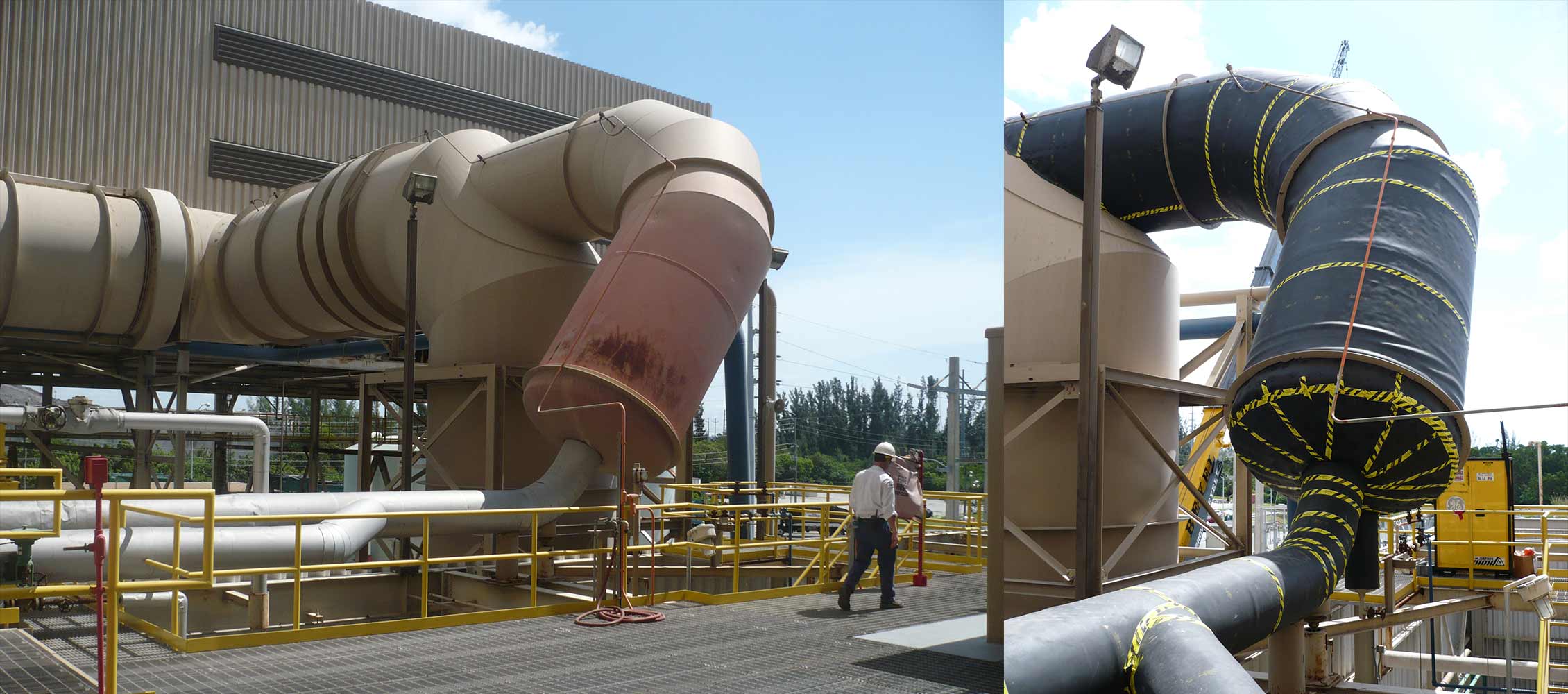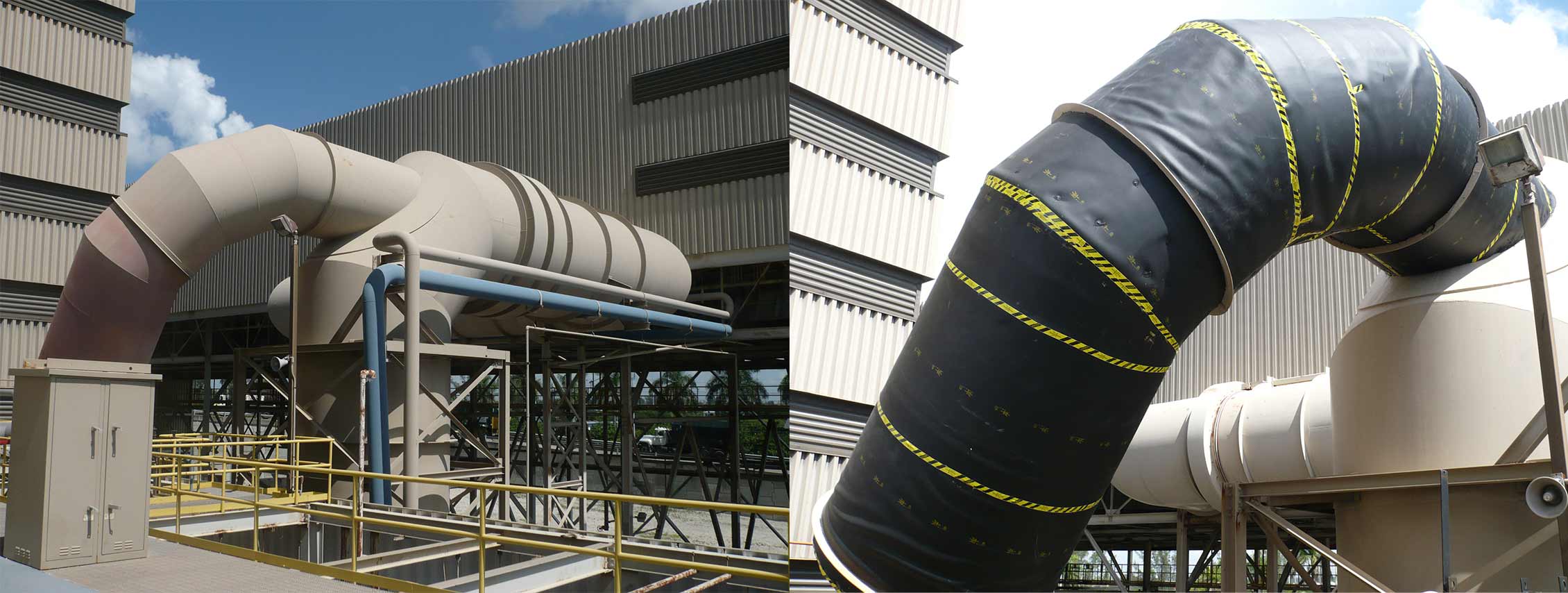Reducing Energy Plant Noise
Waste to Energy Plant Noise Reduction Project

Reducing Energy Plant Noise – Supervisors at the South Broward Waste to Energy (WTE) plant in Fort Lauderdale, Florida were faced with a 30-day project to overhaul the plant’s turbine. During this process the plant’s steam bypass system would take over the turbine’s 24-hours a day waste management responsibilities for one full month.
The problem with the transition was the unbearable blare of the bypass system. The bypass channels 900 pounds per square inch of compressed steam through a 14 inch diameter pipe and into a 7 foot diameter pipe, generating a noise level of 120dB. This is an unsafe level equivalent to a jackhammer breaking up concrete or a jet engine at takeoff.
The noise was so deafening that even with earplugs, employees and visiting contractors could not spend more than brief periods of time in the vicinity of the bypass system without risking hearing damage. Verbal communication was impossible, even if they shouted, while working on or around the system.
Benton said that the need for noise abatement at the plant had been brewing for some time before the turbine overhaul created the incentive he needed to take action. One contractor found the extreme, unrelenting howl of the bypass system so difficult to work with he began to dramatically hike the cost for his crews to work on site.
For crews to work under conditions with such a noise level is actually painful and studies confirm the adverse health effects of industrial noise pollution on workers in such an environment.
“Not only was it a health issue, it had become a financial issue as well,” Benton said. “Contractors were going to charge more to work here, and employees would have to severely reduce their hours to minimize exposure to the noise.”
The decision to install Acoustiblok® sound abatement material to the bypass system was made following an evaluation by Acoustiblok’s Vice-President, Shawn Saathoff. He proposed a blanket application of the Acoustiblok 1/8″ thick proprietary viscoelastic polymer. Acoustiblok’s ease of installation, flexibility, effectiveness and environmentally friendly properties, combined with a Sound Transmission Classification (STC) of 26, made it ideal for the job; especially since the bypass system is composed of pipes elevated more than five stories.
However, while solving the sound abatement issues a new problem arose. The heat emitted from the compressed steam traveling through the bypass system reaches temperatures as high as 350 degrees, while Acoustiblok has a standard application range of 200 degrees before its viscosity is challenged.
After conferring with a Thermablok® representative, the maintenance manager for South Broward WTE, Paul Benton, chose to gird the system with a 5mm layer of Thermablok insulating material before applying the Acoustiblok.
Thermablok adapts aerogel technology developed by NASA to create the highest insulating material in existence. Composed almost completely of air, aerogel is known as “liquid smoke”. Previously, aerogel had been difficult to adapt to most uses because of its fragility. Thermablok overcomes this by using a unique patented fiber to suspend a proprietary formula of aerogel so that it can be bent or compressed while still retaining its amazing insulation properties.
The massive pipes were enveloped first in 1,280 square feet of Thermablok high Temp, then in 1,575 square feet of Acoustiblok by a four-man crew from Coastal Insulation in Pompano Beach, FL. Steve Sill, vice president of Coastal Insulation, said the three week long job was imposing only because of the sheer size of the system.
“It was challenging in that we were working off lifts higher than five stories,” he said.
“But we were surprised how easy the material was to install, and how well it worked. We couldn’t believe the difference,” Sill said after the application of Acoustiblok was complete. “We measured a 26-28dB attenuation, which was significant enough that contractors could actually hold a conversation while standing next to the structure, whereas before you couldn’t be heard if you screamed. This success became even more amazing when the plant manager told us that the factory was running at nearly 50% greater capacity than when the original readings were taken.”
Benton was also amazed at the results of the black Acoustiblok material, seamed with black and yellow Acoustigrip permanent bonding tape, which far surpassed his expectations.
“We wouldn’t have cared if it was magenta with white polka dots, we would use it again we were so happy with the results,” Benton said.


